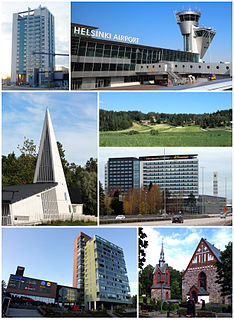
Vantaa is a city and municipality in Finland. It is part of the inner core of the Finnish Capital Region along with Helsinki, Espoo, and Kauniainen. With a population of 237,231, Vantaa is the fourth most populated city in Finland after Helsinki, Espoo and Tampere. Its administrative center is the Tikkurila district.

Espoo is a city and municipality in the region of Uusimaa in the Republic of Finland. It is located on the northern shore of the Gulf of Finland, bordering the cities of Helsinki and Vantaa, while surrounding the enclaved town of Kauniainen. The city covers 528 square kilometres (203.9 sq mi) with a population of 292,913 residents in December 2020, making it the 2nd-most populous city in Finland. Espoo forms a major part of a substantially larger metropolitan area known as Greater Helsinki, home to over 1.5 million people in 2020.

Kauniainen is a small town and a municipality of 10,177 inhabitants in the Helsinki Metropolitan Area, Finland. It is surrounded by the City of Espoo, in the Capital Region of Greater Helsinki. Kauniainen was founded by a corporation in 1906, AB Grankulla, that parcelled land and created a suburb for villas; Kauniainen received the status of a market town in 1920, the Finnish name in 1949, and the title of kaupunki in 1972.
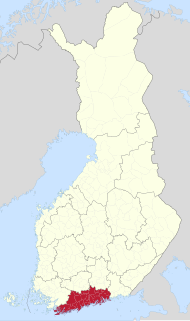
Uusimaa is a region of Finland. It borders the regions of Southwest Finland, Tavastia Proper (Kanta-Häme), Päijänne Tavastia (Päijät-Häme), and Kymenlaakso. Finland's capital and largest city, Helsinki, along with the surrounding Greater Helsinki area, are both contained in the region, and Uusimaa is Finland's most populous region. The population of Uusimaa is 1,703,649.
Pakankylä is a hamlet in the city of Espoo, Finland. The village lies near the Nuuksio National Park and just north of Lake Bodom, the largest lake in Espoo. The village has about 15 houses.

Nuuksio National Park is one of Finland's 40 national parks. Established in 1994, the park spreads over an area of forests and lakes in Espoo, Kirkkonummi and Vihti. North-west from Helsinki, it is the second-closest national park to the capital behind the recently established Sipoonkorpi National Park. The name is derived from the Nuuksio district of Espoo.

Espoon keskus is the central district of Espoo, the second biggest city of Finland and the administrative centre with the city hall of Espoo. The areas of Kiltakallio, Kirkkojärvi, Saarniraivio, Suna, Suvela and Tuomarila belong to Espoon keskus. To the east, Espoon keskus borders the city of Kauniainen, an enclave within the city of Espoo.

Haukilahti is a neighbourhood in Espoo, Finland. It is located on the seashore of the Gulf of Finland in the southern part of the city.
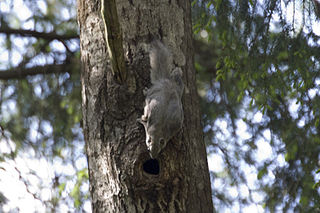
The Siberian flying squirrel is an Old World flying squirrel with a range from the Baltic Sea in the west to the Pacific Coast in the east. It is the only species of flying squirrel found in Europe. It is considered vulnerable within the European Union where it is now found only in Estonia, Finland and Latvia out of the 27 countries in the Union.

Nöykkiö (Finnish) or Nöykis (Swedish) is a district of Espoo, Finland. It was originally known only by its Swedish name Nöykis, but the Finnish name "Nöykkiö" came into use in the 1940s.
Länsiväylä is a motorway in the Greater Helsinki area of Finland, mainly at the Helsinki conurbation. It is part of the Finnish national road 51. The road begins in Ruoholahti in western Helsinki and continues west through the island of Lauttasaari and then across the city border to Espoo. The Länsiväylä road continues all the way throughout the southern part of Espoo. It continues as a motorway until finally crossing the border west to Kirkkonummi.
This is an alphabetical list of the fifty districts of Espoo. Swedish names are given in parentheses.

Mankkaa (Finnish) or Mankans (Swedish) is a suburb of Espoo, located between Tapiola and Kauniainen, with a population of 7,704 (2006), of which 704 speak Swedish as a first language (2005). Most of Mankkaa falls under the postal code 02180, with 02630 being the code of the areas situated near the Helsinki-Turku freeway in the north. The area under postal code 02180 has one of the highest wage incomes in whole of Finland. ref.

Espoo railway station is a railway station in the district of Espoon keskus in the city of Espoo, Finland. It is between the stations of Tuomarila and Kauklahti, about 20 kilometres (12 mi) from the Helsinki Central railway station.

Monica Vikström-Jokela is a Finnish-Swedish television script writer and author from Finland.
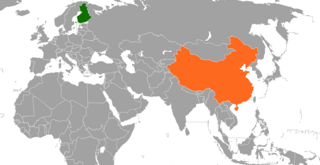
Finnish-Chinese relations are the foreign relations between Finland and China.
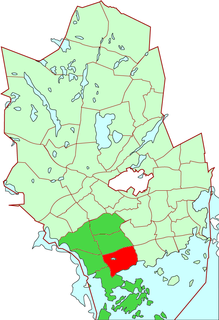
Kaitaa (Finnish) or Kaitans (Swedish) is a district of southern Espoo, Finland, located south of the Länsiväylä highway, with a population of 6000.

Soukka (Finnish) or Sökö (Swedish) is district number 33 of Espoo, Finland, located in southwestern Espoo in the main district of Suur-Espoonlahti.

Lahnus is a district in the city of Espoo and administratively belongs to the Northern Espoo area. It is located near the municipality of Nurmijärvi and its largest village, Klaukkala. The most famous places in Lahnus are the Serena Water Park and Hotel Korpilampi.

Röylä is a district of Espoo, Finland. It is located in the Pohjois-Espoo area, northern shores of the Lake Bodom. Röylä had 410 inhabitants at the turn of the year 2019–2020 and the average age of the residents is 56,6 years. The Swedish name Rödskog literally means "red forest", but it may be an abbreviation of the words rödjad skog, which means a "burn-clearing forest" for agricultural purposes.



















